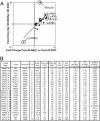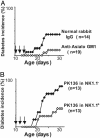Natural killer cells distinguish innocuous and destructive forms of pancreatic islet autoimmunity
- PMID: 15141080
- PMCID: PMC419564
- DOI: 10.1073/pnas.0402065101
Natural killer cells distinguish innocuous and destructive forms of pancreatic islet autoimmunity
Abstract
In both human patients and murine models, the progression from insulitis to diabetes is neither immediate nor inevitable, as illustrated by the innocuous versus destructive infiltrates of BDC2.5 transgenic mice on the nonobese diabetic (NOD) versus C57BL/6.H-2g7 genetic backgrounds. Natural killer (NK)-cell-specific transcripts and the proportion of NK cells were increased in leukocytes from the aggressive BDC2.5/B6.H-2g7 lesions. NK cell participation was also enhanced in the aggressive lesions provoked by CTLA-4 blockade in BDC2.5/NOD mice. In this context, depletion of NK cells significantly inhibited diabetes development. NOD and B6.H-2g7 mice exhibit extensive variation in NK receptor expression, reminiscent of analogous human molecules. NK cells can be important players in type 1 diabetes, a role that was previously underappreciated.
Figures






References
-
- Tisch, R. & McDevitt, H. (1996) Cell 85, 291–297. - PubMed
-
- Verge, C. F., Gianani, R., Yu, L., Pietropaolo, M., Smith, T., Jackson, R. A., Soeldner, J. S. & Eisenbarth, G. S. (1995) Diabetes 44, 1176–1179. - PubMed
-
- Anastasi, E., Campese, A. F., Bellavia, D., Bulotta, A., Balestri, A., Pascucci, M., Checquolo, S., Gradini, R., Lendahl, U., Frati, L., et al. (2003) J. Immunol. 171, 4504–4511. - PubMed
-
- Robles, D. T., Eisenbarth, G. S., Dailey, N. J., Peterson, L. B. & Wicker, L. S. (2003) Diabetes 52, 882–886. - PubMed
-
- Haskins, K., Portas, M., Bradley, B., Wegmann, D. & Lafferty, K. J. (1988) Diabetes 37, 1444–1448. - PubMed
Publication types
MeSH terms
Substances
Grants and funding
LinkOut - more resources
Full Text Sources
Other Literature Sources
Medical
Molecular Biology Databases

